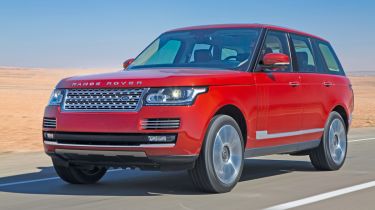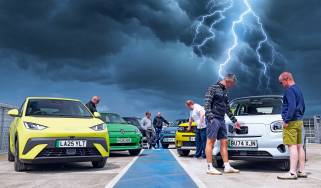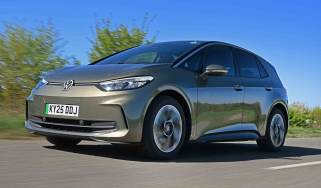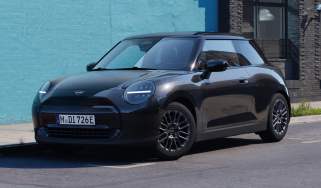New Range Rover 3.0 TDV6 Autobiography
We get behind the wheel of the all-new Range Rover for the first time

An automotive icon improved. The new Range Rover does the luxury thing better than many more expensive luxury cars, with off-road ability that’s the best bar none. It’s not quite perfect – access and space in the back isn’t fantastic and we’re not fans of the touchscreen infotainment system. But it gets closer to perfect than anything else at the money and is a fantastic engineering and styling achievement.
It's been 10 years since the last new Range Rover – an absolute age in automotive terms – yet the outgoing car still does a brilliant job of crossing over between luxury car and 4x4. In plain English, that means it’s a tough act to follow.
This all-new Range Rover takes a hi-tech approach, with the highlight being an aluminium bodyshell (using Jaguar know-how) that sheds weight to improve efficiency – the biggest criticism of the old model.
The new car may be slightly longer and wider, with more kit on board, but fitted with the new 3.0-litre V6 diesel, it’s 420kg lighter than the old TDV8 model.
It’s hugely noticeable. The new car feels lighter on its feet, while the smaller V6’s performance pretty much matches the old V8. The steering is lighter and more alert, too – the Rangie turns into bends more keenly, while there’s more front-end grip and less body lean. A wider track and wider tyres (on myriad wheel designs) help improve poise.
Used - available now

2021 Land Rover
Range Rover
30,332 milesAutomaticPetrol2.0L
Cash £39,995
2017 Land Rover
Range Rover
76,100 milesAutomaticDiesel4.4L
Cash £23,995
2020 Land Rover
Range Rover
41,437 milesAutomaticDiesel3.0L
Cash £40,000
2021 Land Rover
Range Rover
46,647 milesAutomaticDiesel3.0L
Cash £41,750In spite of the car’s swift acceleration – 0-60mph in 7.4 seconds isn’t to be sniffed at in a car of this size – this is no sports car: it’s still a heavy, tall off-roader.
The weight loss pays dividends in the V8 diesel version, too, where a long, seamless stream of sheer grunt is available at pretty much any speed. As for the supercharged 5.0-litre petrol, its 0-60mph time of 5.1 seconds is the stuff of sports cars, albeit with a fuel bill to match.
Back to the V6, though, and official figures promise an average economy figure of 37.7mpg, helped by stop-start (on this model only). Even taking into account a drop in the real world, that’s impressive stuff for such a big car – another benefit of the latest Range Rover’s diet.
As is the ride. Range Rovers have always had a good ride, but with a slight bobblyness. No more – there’s a new serenity to the way the car rides. Over the ropey roads of our test route in Morocco, the Rangie remained unflustered, dismissing ruts that would usually leave you wincing.
The other big improvement is refinement. Even with the sleeker front end and flush glazing, it’s still quite a big, bluff-fronted machine to get through the air. But around town it’s virtually silent, as it is on the motorway. There’s a whiff of wind noise, but the engine could be switched off and the tyres floating above the road surface. Land Rover says it’s quieter than a Bentley around town and makes an Audi A8 seem shouty at 100mph.
Bentley has also been benchmarked with the new interior, while Land Rover has been bold enough to mention the Rolls-Royce Ghost in the same breath. And yes, the cabin class and quality has been moved up to those exalted levels.
There’s been a reduction in the number of buttons by 50 per cent, while a wider choice of stylish (low carbon) leathers, plus an array of exterior colour schemes (including contrasting roofs) means a total of 18,000 potential trim combinations.
There may be fewer buttons on the dash, but many have been transferred to the touchscreen system, which doesn’t seem to have taken the giant strides the rest of the car has – it still takes too many fingerprint-leaving prods of the screen to complete simple functions. BMW’s (and consequently Rolls-Royce’s) iDrive is still the standard-setter.
The TFT display now shows full-colour nav instructions, though. But there’s no choice of display – a digital readout would be nice, rather than the analogue-effect rev-counter and speedo.
There’s plenty of new tech on board, however, from heated and cooled seats that’ll also massage you, to an awesome 29-speaker, 1,700-watt Meridian sound system. There’s an Evoque-style full-length glass roof (although it opens on the Range Rover), while the doors will pull themselves to a close and the familiar split tailgate is powered, too.
Also recognisable is the regal view out, in spite of what seems to be a widening of the A and B-pillars, due in part to tough US roll-over tests, and in part the use of aluminium. You sit high in hugely comfortable and easily adjustable armchairs, with a near-perfect relationship between steering wheel, rotary gear selector and elbow perches – that’s something Land Rover has always done well.
The longer wheelbase means there’s a bit more room in the back now, but this is one area where the new Range Rover still can’t compete with conventional luxury cars. Even with the air-suspension set to access level, it’s still quite a jump up into the car and, for skirt-wearing ladies avoiding the prying lenses of the paparazzi, a knees-together slide out. The rear wheelarch also makes getting in and out of the rear a bit tricky – the long-wheelbase version that’s due out next year should partly cure that problem, though.
But this is still definitely one of the coolest cars to be seen in. The unmistakable Range Rover cues are all there: clamshell bonnet, floating roof and that cab-rearward profile. But the sleeker nose, with its intricate silver grille and striking LED running lights are real eye catchers, as are the gills on the side of the car and the wraparound lights. These last two are designed to visually shorten the side view, which looks longer due to the roof’s rearwards slope.
Of course, the Range Rover has always been able to do one thing its rivals can’t – go anywhere. Or at least to places that other 4x4s can’t reach.
All this doesn’t come cheap, though – prices start at £71,295, a £1,300 increase over the old model. But with first deliveries due in January and much of next year’s production already sold, residual values should be strong. And it’s not surprising, given the Range Rover’s unique talents.




